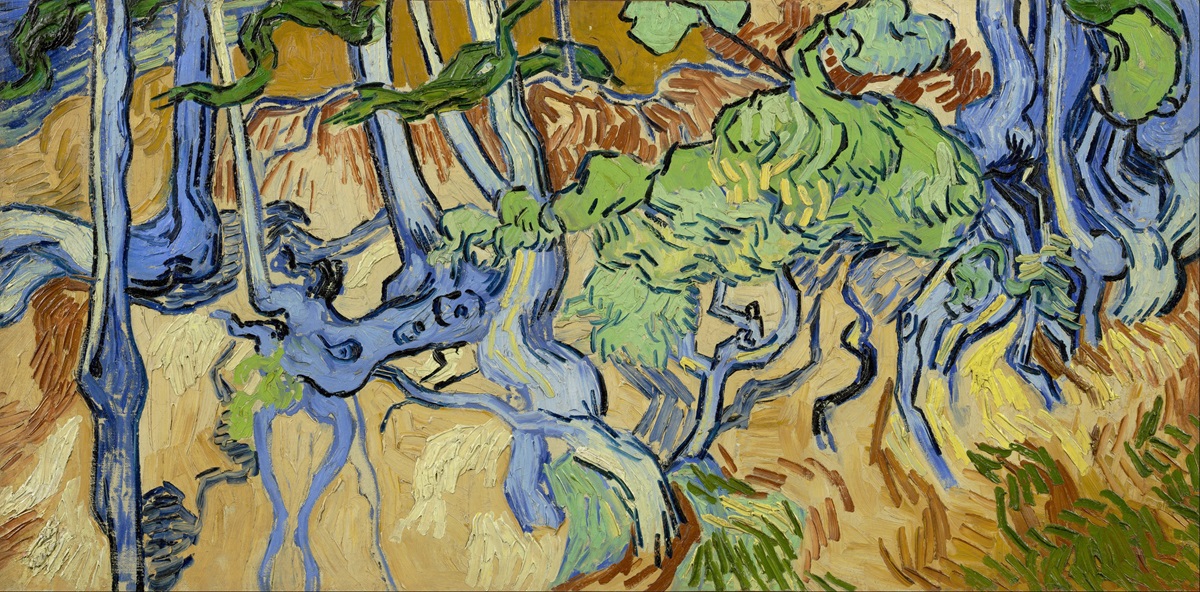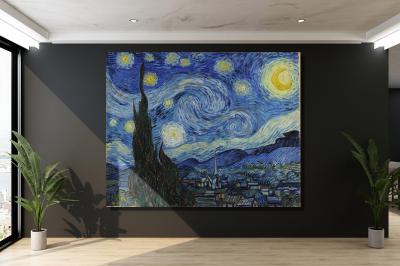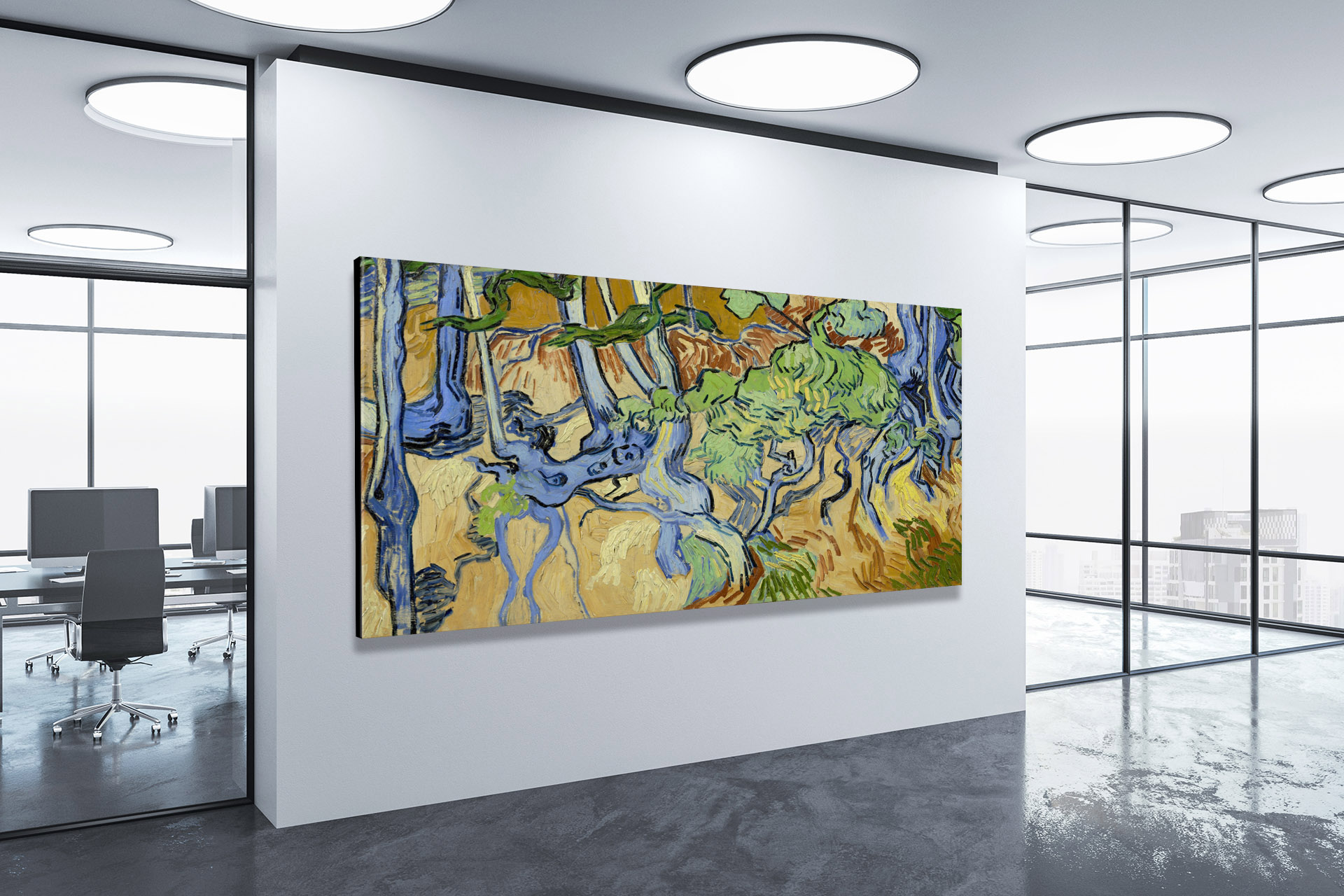Tree Roots
By Vincent van Gogh, 1890
Unearthing the Soul: Vincent van Gogh’s “Tree Roots”
Vincent van Gogh, the renowned Dutch Post-Impressionist painter, has left an indelible mark on the world of art with his ability to capture the essence of the world around him. While his masterpieces like “Starry Night” and “Sunflowers” have garnered widespread recognition, it is essential not to overlook some of his lesser-known works, such as “Tree Roots.” This painting, created with remarkable emotional intensity, offers a profound glimpse into van Gogh’s artistic soul. In this extended exploration, we will dive deeply into the captivating world of “Tree Roots,” unraveling the layers of emotion, symbolism, and artistic innovation that make it a treasure in the art world.
The Life and Times of Vincent van Gogh
Before we embark on our journey into the intricate world of “Tree Roots,” it’s crucial to understand the context in which this masterpiece was conceived. Vincent van Gogh was born on March 30, 1853, in Zundert, Netherlands. His life was characterized by a relentless pursuit of art, despite a series of personal struggles and mental health issues. Van Gogh’s relatively brief yet incredibly prolific career produced over 2,000 works of art, each a confirmation to his distinctive style and exploration of color and emotion.
“Tree Roots,” painted in 1890 during van Gogh’s stay in Auvers-sur-Oise, France, represents a period of intense artistic growth and self-reflection. It was created in the twilight of his life, just a few months before his tragic suicide, and serves as a poignant reflection of his inner turmoil and profound connection to nature.
“Tree Roots” Large Canvas Prints from WhiteClouds
The Physicality of “Tree Roots”
Although “Tree Roots” is relatively small in scale, measuring just 50 x 100 cm, its impact is monumental. The canvas is dominated by the intricate, gnarled, and interwoven roots of an upturned tree, exposed to the elements. What sets this painting apart is van Gogh’s distinctive technique, characterized by thick, impasto brushstrokes that create a tactile quality. As we gaze upon the canvas, it feels as if we could reach out and touch the texture of the roots and earth beneath our fingertips.
Van Gogh’s use of texture in “Tree Roots” posed technical challenges that pushed the boundaries of traditional painting. The impasto technique, involving the application of thick layers of paint, allowed van Gogh to create a three-dimensional effect that almost sculpted the roots onto the canvas. This innovative approach was a departure from the smooth, blended brushwork of his contemporaries and showcased van Gogh’s pioneering spirit in the realm of Post-Impressionism.
Color plays a pivotal role in the painting’s emotional resonance. Van Gogh employs a vibrant palette of earthy tones, ranging from deep browns to warm ochres, to capture the rich, organic nature of the roots and soil. Against this earthy backdrop, bright green shoots and tufts of grass emerge, symbolizing the tenacity of life amidst adversity.
The Emotional Landscape of “Tree Roots”
It is essential to acknowledge the emotional undercurrents that course through “Tree Roots.” Van Gogh’s mental state at the time of creating this masterpiece significantly influenced its emotional depth. The twisted and exposed roots can be seen as a metaphor for his own inner struggles, a reflection of the turbulence within his mind. The contorted roots reaching out from the canvas suggest a sense of restlessness and yearning, mirroring van Gogh’s own quest for meaning and connection.
Yet, amidst the turmoil, there is also a sense of vitality in “Tree Roots.” The tenacious green shoots represent hope and renewal, suggesting that even in the darkest moments of despair, there is always the potential for growth and rejuvenation. It is as though van Gogh is reminding us that life persists, even in the face of adversity.
Symbolism and Interpretation
As with many of van Gogh’s works, “Tree Roots” is open to interpretation, and its symbolism can vary from viewer to viewer. Some art historians see the painting as a reflection of the cyclical nature of life, death, and rebirth. The exposed roots, upturned and exposed, mirror the transient nature of existence. The green shoots and grass symbolize the eternal cycle of renewal, suggesting that life continues to flourish despite the inevitability of decay.
Others interpret “Tree Roots” as an exploration of the human psyche and the hidden depths within the human soul. The exposed, twisting roots could represent the complexities of our inner world, the hidden aspects of ourselves that we may be hesitant to confront. Van Gogh, through this painting, seems to encourage us to embrace our inner complexities and delve into the depths of our own souls.
Location and Historical Context
“Tree Roots” is currently housed in the Van Gogh Museum in Amsterdam, Netherlands. The museum, dedicated to the life and works of Vincent van Gogh, provides a fitting backdrop for this masterpiece, allowing visitors to immerse themselves in the artist’s world.
Auvers-sur-Oise, the location where van Gogh painted “Tree Roots,” holds historical significance as the place where the artist spent his final days. The quaint French village provided van Gogh with an abundance of subject matter for his paintings, from picturesque landscapes to ordinary scenes of rural life. In “Tree Roots,” van Gogh sought to capture the essence of the natural world that surrounded him during this tumultuous period of his life.
Vincent van Gogh: The Man Behind the Brush
Vincent van Gogh’s life story is as compelling as his art. Born into a family of modest means, he struggled with mental health issues throughout his life. His artistic journey was marked by poverty, isolation, and periods of profound despair. Yet, despite these challenges, he possessed an unwavering passion for art.
Van Gogh’s artistic evolution is a testament to his dedication and growth as a painter. He began his career as a largely self-taught artist, experimenting with various styles and techniques. Over time, he developed his unique style, characterized by bold colors, dramatic brushwork, and an exploration of emotion.
The artist’s connection to nature was profound and enduring. “Tree Roots” is just one example of his deep appreciation for the natural world. Van Gogh believed that nature held the key to understanding the human experience, and he often sought solace and inspiration in the landscapes he painted.
 Tree Roots by Vincent van Gogh
Tree Roots by Vincent van Gogh
Conclusion
“Tree Roots” is not just a painting; it is a profound exploration of the human condition and our relationship with the natural world. Vincent van Gogh, despite his personal struggles, continues to inspire and captivate the world with his timeless art. This masterpiece invites us to contemplate our own struggles, the hidden depths within us, and the enduring beauty of life itself.
As we gaze upon the twisting roots and the resilient green shoots in “Tree Roots,” we are reminded that, like van Gogh, we too can find strength and hope in the most unexpected places. This small yet powerful painting serves as a window into the soul of an artist who, through his work, encourages us to peel back the surface layers of our existence and uncover the raw, unfiltered beauty that lies beneath. “Tree Roots” confirms the enduring power of art to transcend time and speak to the human spirit, while also showcasing van Gogh’s technical innovation and the historical context of its creation in Auvers-sur-Oise.
Frequently Asked Questions About “Tree Roots”
What is the significance of “Tree Roots” in Vincent van Gogh’s body of work? “Tree Roots” holds significance as it reflects van Gogh’s connection to nature and his exploration of the human condition. It’s a testament to his unique style and emotional intensity.
Where and when was “Tree Roots” painted, and what was the artist’s state of mind during that period? “Tree Roots” was painted in 1890 in Auvers-sur-Oise, France. During this period, van Gogh was struggling with mental health issues, which adds depth to the emotional content of the painting.
What inspired van Gogh to paint the twisted and exposed roots of a tree? Van Gogh was inspired by the natural surroundings of Auvers-sur-Oise. He found beauty and symbolism in the twisted roots, which reflected his own inner struggles.
What is the symbolism behind the upturned tree roots in the painting? The upturned roots can symbolize the fragility of life, the idea of uprootedness, and the persistence of growth in adversity.
How does van Gogh’s use of impasto technique contribute to the overall impact of “Tree Roots”? Van Gogh’s impasto technique creates a tactile quality, making the roots appear almost three-dimensional. It adds depth and texture to the painting, intensifying its emotional impact.
Can you provide insights into the colors used in the painting and their symbolic meanings? The earthy tones represent the organic nature of the roots and soil. The bright green shoots symbolize hope, renewal, and the persistence of life.
How does “Tree Roots” fit into the Post-Impressionist movement, and what sets it apart from other works of that era? “Tree Roots” exemplifies Post-Impressionism through its bold colors and textured brushwork. What sets it apart is its subject matter, focusing on nature’s rawness and the artist’s emotional turmoil.
Are there any known personal connections or anecdotes related to this painting in van Gogh’s life? While there are no specific anecdotes related to “Tree Roots,” it is believed to reflect van Gogh’s personal struggles and his deep connection to nature.
What is the historical context of Auvers-sur-Oise, the location where “Tree Roots” was created, and how does it influence the interpretation of the artwork? Auvers-sur-Oise was a picturesque village where van Gogh spent his final days. Its rural beauty and tranquil setting inspired many of his works, including “Tree Roots.”
How has the public’s perception of “Tree Roots” evolved over time, and what critical acclaim or recognition has it received? Over time, “Tree Roots” has gained recognition as an emotionally charged masterpiece. It is now celebrated for its depth and symbolism.
Are there any notable exhibitions or events where “Tree Roots” has been featured or discussed? “Tree Roots” has been part of various exhibitions dedicated to van Gogh’s work, including retrospectives at the Van Gogh Museum in Amsterdam.
What are some alternative interpretations or theories about the meaning of “Tree Roots”? Some interpretations suggest it represents the duality of life and death, while others focus on its connection to van Gogh’s mental state.
Can you elaborate on the conservation efforts and techniques used to preserve “Tree Roots” and other van Gogh paintings? Conservation efforts include controlled environments, careful handling, and periodic restoration to ensure the longevity of the artwork.
Has “Tree Roots” ever been subject to theft, forgery, or any notable controversies? “Tree Roots” has not been subject to theft or major controversies, as it resides in a well-secured museum.
Are there any famous quotes or writings by van Gogh himself or art critics discussing “Tree Roots”? While specific quotes about “Tree Roots” may be limited, van Gogh’s letters often reflect his passion for nature and the emotional depth of his work.
How does “Tree Roots” compare to other van Gogh paintings in terms of style, technique, and emotional depth? “Tree Roots” shares van Gogh’s signature style and emotional intensity with other works but stands out due to its unique subject matter.
What can we learn about van Gogh’s artistic evolution and personal struggles by studying “Tree Roots”? “Tree Roots” provides insight into van Gogh’s evolving style and his ability to convey his inner turmoil through art.
Are there any noteworthy artistic influences or inspirations that can be identified in this painting? While there are no direct influences, van Gogh’s love for nature and the Post-Impressionist movement played a role in its creation.
Can you recommend any books, articles, or documentaries that provide in-depth analysis and information about “Tree Roots” by Vincent van Gogh? Some recommended sources include books like “Van Gogh: The Life” by Steven Naifeh and Gregory White Smith, as well as academic articles on van Gogh’s works.
Is “Tree Roots” available for public viewing, and if so, where can it be seen in person? “Tree Roots” is housed in the Van Gogh Museum in Amsterdam, where it can be viewed by the public, providing a unique opportunity to appreciate its beauty and depth in person.
Other Articles on Vincent van Gogh Paintings
At Eternities Gate by Vincent Van Gogh, 1890
Blossoming Almond Tree by Vincent Van Gogh, 1890
Cafe Terrace at Night by Vincent Van Gogh, 1888
Daubigneys Garden by Vincent Van Gogh, 1890
Green Wheat Field with Cypress by Vincent Van Gogh, 1889
Houses at Auvers by Vincent Van Gogh, 1890
Irises by Vincent Van Gogh, 1889
Night Café by Vincent Van Gogh, 1888
Portrait of Dr. Gachet by Vincent Van Gogh, 1890
Red Vineyards by Vincent Van Gogh, 1888
Road with Cypress and Star by Vincent Van Gogh, 1890
Starry Night by Vincent Van Gogh, 1889
Starry Night over the Rhone by Vincent Van Gogh, 1888
Sunflowers by Vincent Van Gogh, 1887
The Bedroom by Vincent Van Gogh, 1888
The Church at Aurers by Vincent Van Gogh, 1890
The Garden of the Asylum by Vincent Van Gogh, 1889
The Mulberry Tree by Vincent Van Gogh, 1889
The Potato Eaters by Vincent Van Gogh, 1885
The Yellow House by Vincent Van Gogh, 1888
Tree Roots by Vincent Van Gogh, 1890
Van Gogh Self Portrait by Vincent Van Gogh, 1887
Vase with Red Poppies by Vincent Van Gogh, 1886
View of Arles by Vincent Van Gogh, 1889
Wheat Field with Crows by Vincent Van Gogh, 1890
Wheat Field with Cypresses by Vincent Van Gogh, 1889
More WhiteClouds Videos
Contact us today to learn more about our 3D services and how we can help you achieve your goals.

